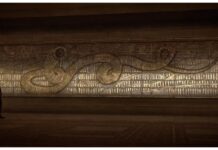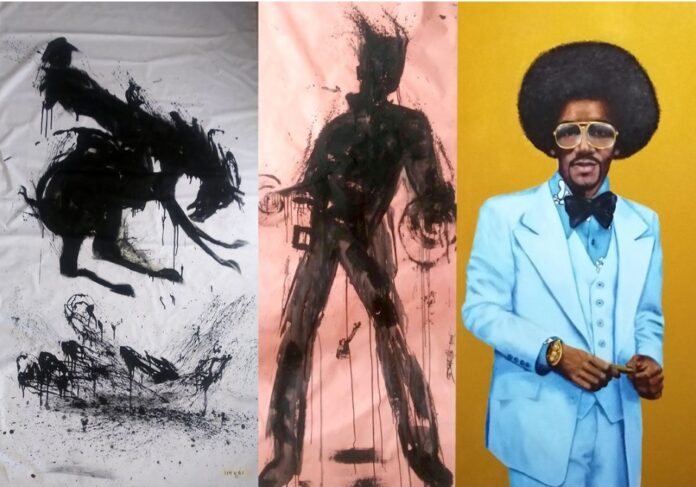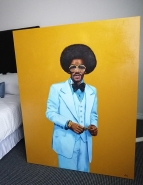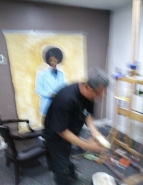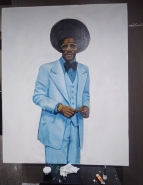A California graphic designer has pleaded guilty to selling over $1 million of forged paintings by renowned artists like Richard Hambleton and Barkley Hendricks to New York galleries, authorities said.
Jason Harrington, 38, of Escondido, Calif. admitted he had sold fake works of art to at least 15 arthouses and other buyers between 2018 and 2o20, pocketing $1.1 million for paintings barely worth the canvases they were drawn on, federal prosecutors said.
“Forged artwork harms investors, corrupts the integrity of the art market, and damages the historical-cultural record,” said Randy Grossman, acting U.S. Attorney for the Southern District of California.
‘Forged artwork harms investors, corrupts the integrity of the art market, and damages the historical-cultural record.’— Randy Grossman, acting U.S. Attorney for the Southern District of California
Harrington’s attorney, Jeremy Warren, described his client as a “down on his luck,” graphic artist, who had learned how to execute the fraud from others and “had just run with it.”
“He feels bad about what he did. He’s a decent guy and didn’t mean to hurt anyone,” Warren said.
Court records didn’t name the galleries and dealers who were swindled in the case.
Harrington specialized in forging works by Hambleton, a New York street artist and contemporary of Jean-Michel Basquiat and Keith Haring, who rose to prominence in the early 1980s with his Shadowman paintings featuring a black-silhouetted figure, prosecutors said. Hambleton died in 2017 and his paintings have sold for hundreds of thousands of dollars.
‘He feels bad about what he did. He’s a decent guy and didn’t mean to hurt anyone.’— Jeremy Warren, attorney for Jason Harrington
Investigators eventually caught on to the fraud after Harrington approached a private art dealer in New York in late 2019 saying he had two Hambleton Shadowman paintings he was looking to sell — one on an unstretched canvas, and the other on a stop sign, according to the criminal complaint.
As proof of provenance, Harrington provided a letter from a woman he said was his wife, and who wrote that she had been friends with Hambleton in New York and had bought the paintings from him at a discounted price in 2011, prosecutors said. The dealer agreed to pay $19,970 for the stop sign painting.
When the dealer listed the work for sale on an art web page, an employee of the site noted that some suspicious Hambleton works had been surfacing on the market from southern California. Upon closer inspection, the dealer realized the work was a phony, prosecutors said.
Around the same time, Harrington contacted another “prominent art dealer,” offering two Hambleton paintings that featured common motifs of his work with a similar story about his wife. The dealer eventually grew suspicious when she asked to speak to the wife, and Harrington put her on the phone with a woman who spoke little English and mispronounced Greenwich Village, prosecutors said.
Authorities found evidence that the image of a man in one painting had been taken from a Wikipedia page, ‘1970s in fashion.’
Then Harrington approached a gallery that specialized in selling works by Black artists, saying he had a painting by Hendricks he wanted to sell. Hendricks was a renowned portrait artist whose paintings featured lustrous images of Black subjects. He also died in 2017.
Harrington then sent photos of a striking painting featuring a young Black man with an afro, wearing a powder blue suit against a gold background. He told the dealer that the man was his uncle Larry who had met Hendricks at a garage sale in Mystic, Conn. in 1972 and that the artist had agreed to paint his portrait in exchange for Larry’s jazz record collection. The dealer said that if the story could be verified, the portrait could be worth as much as $2 million.
But then the dealer contacted Hendricks’ widow, who said the painting and signature didn’t appear authentic. She also said that her husband kept detailed records of all his works and that this painting was not included in his files. The dealer decided that the painting was likely a fraud and contacted authorities.
According to the criminal complaint, investigators got a search warrant for the Google GOOGL, -1.86% GOOG, -2.07% account Harrington had used to communicate with the dealers and found numerous photos showing the Hambleton and Hendricks forgeries in various states of completion. They also found evidence that the image of the man in the powder blue suit had been taken from a Wikipedia page titled “1970s in fashion.”
Harrington was arrested in March and charged with wire fraud. He is scheduled to be sentenced on Oct. 22.





